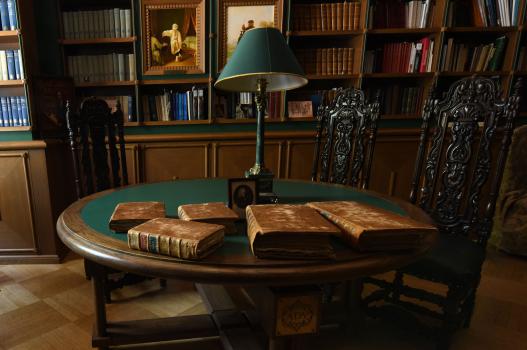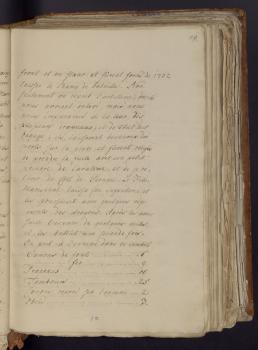Structure
About the Documents
The handwritten materials brought to St. Petersburg by Voltaire's secretary Jean-Louis Wagnière in 1779 were not bound. Arranging the philosopher’s books and papers in the Winter Palace (now the Hermitage), Wagnière grouped them into future volumes. Some of them have a title page or note indicating for what volume the group of papers was intended. The lack of sufficient time of Voltaire's secretary explains the inconsistency in the grouping of documents, and sometimes the incorrect order of sheets. Among the papers of the Cabinet of Catherine II, there is a 1780 case regarding the payment to "the bookbinder Thomas for the binding of eighteen volumes of Voltaire’s manuscripts"1. Of these eighteen volumes, thirteen are actually Voltaire’s papers – drafts, correspondence, extracts, etc. – were bound in red marroquin, and five volumes of materials for the History of the Russian Empire under Peter the Great were bound in calfskin.
These documents were sorted by format and bound into two folio-sized volumes, consisting almost exclusively of papers sent from St. Petersburg (volumes 1 and 2), and three quartor-sized volumes. It is more difficult to know the sources of the papers found in volumes 3, 4 and 5. Most of them were collected by Voltaire himself. Undoubtedly, only a number of statistical tables in volume 5 were sent from St. Petersburg. During binding, some of the papers were left aside, and one and a half hundred sheets, probably intended for the second volume, were stapled into a separate notebook under a cardboard binding.
On this digital resource, documents are grouped into volumes and arranged in the order in which they are bound.
The sheets were probably numbered at the beginning of the 20th century, when the manuscripts were given to the French researcher Fernand Caussy who prepared a brief description of all Voltaire's manuscripts stored in the Imperial Public Library. This numbering does not follow modern archival principles – blank sheets are not numbered – however, it is fixed in the Inventory of Voltaire's Manuscripts, published by Fernand Caussy in 19132, and then in a more detailed description placed in the newest Complete Works of Voltaire as an appendix to the History of the Russian Empire under Peter the Great3. A number is written in blue pencil in the center at the bottom of each sheet that is a multiple of five. The exception is Volume 5 where each sheet is numbered in pencil in the bottom right corner. We use this numbering of sheets in our descriptions.
In the case of multi-part documents, it is not always easy to decide whether their fragments are independent items or part of the whole. For convenience of description and brevity of cross-references, we use the division into documents and their continuous numbering proposed by the publishers of History in «Истории…» в Œuvres complètes de Voltaire4. This numbering includes the volume number and the document number within the volume (ms 1.1, ms 1.2, etc.).
Principles of Presentation of Materials
Scanned pages are accompanied by transliteration and translation or brief content.
Transliteration is as close as possible to the original, because is intended to make the document easier to read as opposed to a “paper” publication. On the contrary, when translating, to make the text readable, we broke long sentences into smaller ones and parts of the text into paragraphs if necessary.
The commentary is divided into two areas: actual comments on the text and other specific explanations in the form of notes on individual words; a general commentary revealing the historical background and circumstances of the document’s writing can be found in the annotation. The main bibliography and links to relevant Internet resources are also given here.
Each document is provided with a brief archaeographic description which can be viewed by clicking on the link from the manuscript shelfmark.
Some documents have not been published in full and will be seen in their entirety after publication in the collection of materials from Voltaire’s Petrine Archives.
Search Options
At this stage, the Depository Information Retrieval System has the option to search by keywords throughout the all manuscripts, at the stage of the completed project – also by toponyms (including the place of the manuscript's origin) and personalities (in addition to the persons mentioned, also by the name of the author of the text, scribe, author of the note, previous owner of the manuscript).

